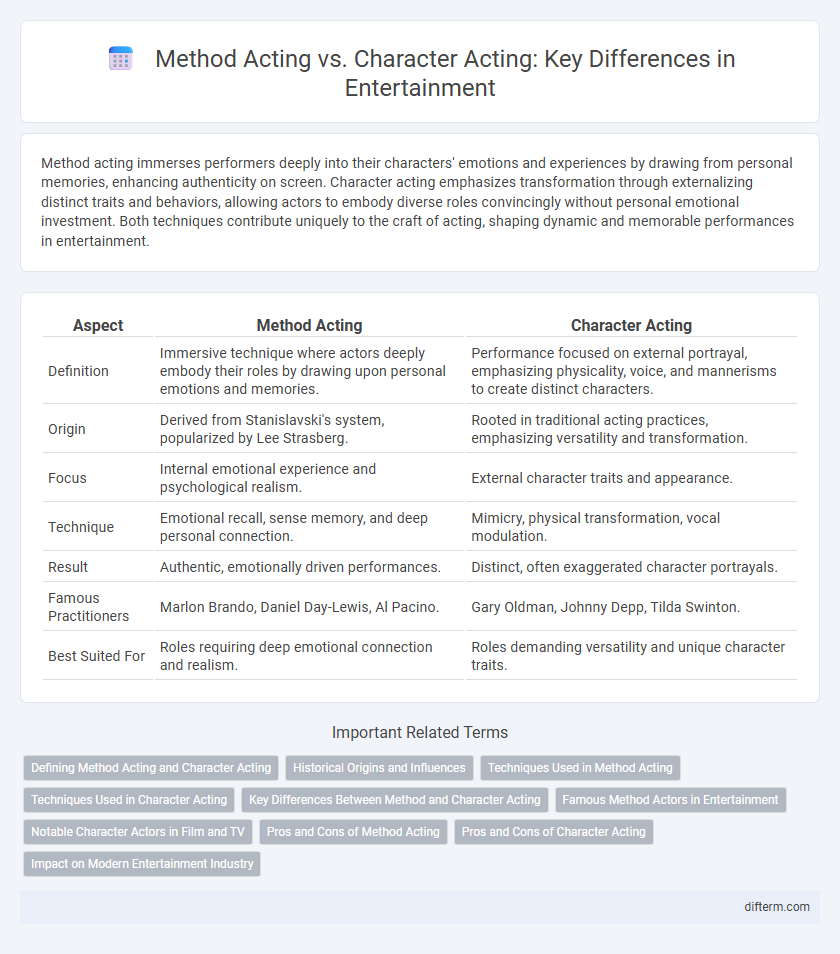Method acting immerses performers deeply into their characters' emotions and experiences by drawing from personal memories, enhancing authenticity on screen. Character acting emphasizes transformation through externalizing distinct traits and behaviors, allowing actors to embody diverse roles convincingly without personal emotional investment. Both techniques contribute uniquely to the craft of acting, shaping dynamic and memorable performances in entertainment.
Table of Comparison
| Aspect | Method Acting | Character Acting |
|---|---|---|
| Definition | Immersive technique where actors deeply embody their roles by drawing upon personal emotions and memories. | Performance focused on external portrayal, emphasizing physicality, voice, and mannerisms to create distinct characters. |
| Origin | Derived from Stanislavski's system, popularized by Lee Strasberg. | Rooted in traditional acting practices, emphasizing versatility and transformation. |
| Focus | Internal emotional experience and psychological realism. | External character traits and appearance. |
| Technique | Emotional recall, sense memory, and deep personal connection. | Mimicry, physical transformation, vocal modulation. |
| Result | Authentic, emotionally driven performances. | Distinct, often exaggerated character portrayals. |
| Famous Practitioners | Marlon Brando, Daniel Day-Lewis, Al Pacino. | Gary Oldman, Johnny Depp, Tilda Swinton. |
| Best Suited For | Roles requiring deep emotional connection and realism. | Roles demanding versatility and unique character traits. |
Defining Method Acting and Character Acting
Method acting involves actors deeply immersing themselves into the emotional life and experiences of their character, often drawing from their personal memories to deliver a realistic performance. Character acting focuses on adopting distinctive traits, behaviors, and physical appearances to portray diverse, often supporting roles with strong individuality. Both techniques demand a high level of skill but differ in their approach to embodying a character's essence.
Historical Origins and Influences
Method acting finds its historical origins in the early 20th century, influenced by Konstantin Stanislavski's system that emphasized emotional truth and deep character immersion. Character acting traces back to theatrical traditions rooted in Commedia dell'arte and Shakespearean drama, focusing on distinctive, often exaggerated personas. These divergent influences shaped modern acting techniques, with method acting prioritizing psychological realism and character acting highlighting external embodiment.
Techniques Used in Method Acting
Method acting techniques emphasize emotional memory recall, sense memory exercises, and deep character immersion to create authentic performances. Practitioners often use affective memory to relive personal experiences, enabling a genuine emotional connection to the character. This approach contrasts with external techniques by prioritizing internalization and psychological realism in acting craft.
Techniques Used in Character Acting
Character acting employs techniques such as exaggerated physical gestures, distinctive vocal patterns, and immersive backstory creation to convincingly portray unique personalities, often relying on external transformation rather than internal emotional recall. This approach prioritizes observable traits and consistency in mannerisms, allowing actors to embody roles that are markedly different from their own identity. Unlike method acting, which emphasizes deep emotional memory and psychological experience, character acting focuses on detailed characterization through deliberate and stylized choices.
Key Differences Between Method and Character Acting
Method acting involves immersive emotional recall and personal experience to deeply inhabit a role, often requiring intense psychological preparation and sustained emotional connection. Character acting focuses on external transformation through physicality, voice, and mannerisms to portray distinct and often supporting roles without necessarily drawing on the actor's own emotions. The key difference lies in method acting's emphasis on internal emotional truth versus character acting's reliance on external, observable traits.
Famous Method Actors in Entertainment
Famous method actors such as Daniel Day-Lewis, Robert De Niro, and Marlon Brando immerse themselves deeply into their characters, often living the role off-screen to capture authentic emotions and behaviors. Character acting, exemplified by actors like Steve Buscemi and Kathy Bates, focuses on portraying distinctive, often supporting roles with a strong emphasis on unique traits and mannerisms. Method acting demands intense personal transformation, while character acting highlights versatility and the ability to create memorable personas across diverse genres.
Notable Character Actors in Film and TV
Notable character actors like Steve Buscemi and Kathy Bates consistently deliver nuanced performances that enrich film and TV narratives without relying on full immersion into their roles, distinguishing them from method actors. Their ability to embody distinct, memorable characters enhances storytelling by adding depth and authenticity, often supporting leading roles with unique presence. This skill set emphasizes versatility and psychological depth over the emotional intensity typically associated with method acting.
Pros and Cons of Method Acting
Method acting, rooted in Stanislavski's system and popularized by Lee Strasberg, immerses actors deeply into their characters' emotions and experiences, enhancing authenticity and emotional intensity. The approach's benefits include creating compelling, believable performances that resonate with audiences, but it often demands intense psychological commitment, risking emotional exhaustion or blurred boundaries between actor and role. Critics argue method acting can limit spontaneity and flexibility, potentially narrowing an actor's range over time.
Pros and Cons of Character Acting
Character acting offers versatility by allowing actors to inhabit diverse and often unconventional roles, enhancing storytelling depth and audience engagement. However, it may limit mainstream recognition and typecast performers into niche roles, restricting career opportunities. The emphasis on transforming physical appearance and adopting unique mannerisms can also demand significant time and emotional investment.
Impact on Modern Entertainment Industry
Method acting revolutionized the modern entertainment industry by promoting deep emotional immersion and authenticity, influencing actors like Daniel Day-Lewis and Marlon Brando. Character acting, focusing on versatility and transformation, remains essential for supporting roles that enrich storytelling, with actors such as Steve Buscemi and Tilda Swinton exemplifying this craft. Both techniques continue to shape film and theater by pushing boundaries in performance quality and audience engagement.
Method acting vs character acting Infographic

 difterm.com
difterm.com